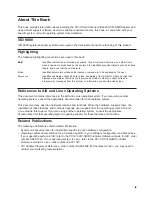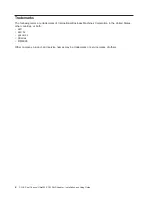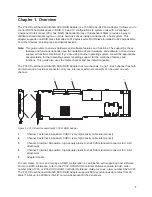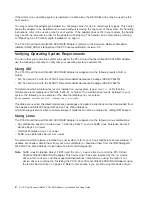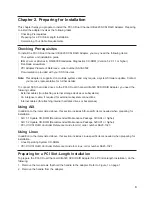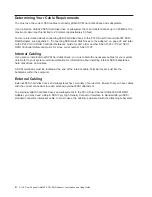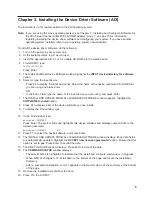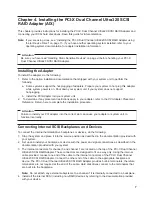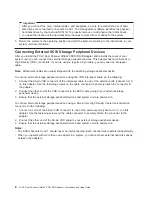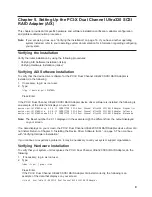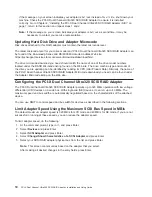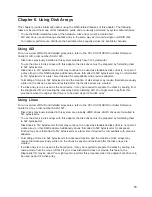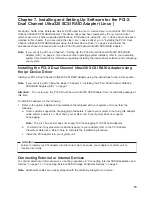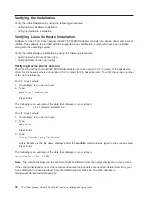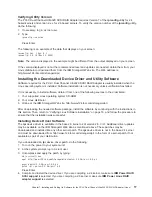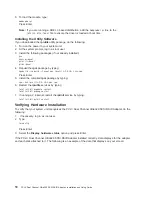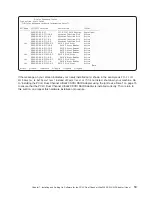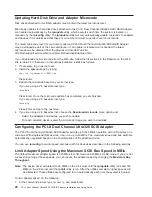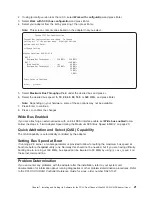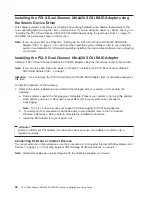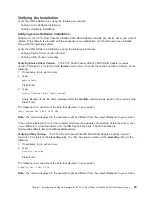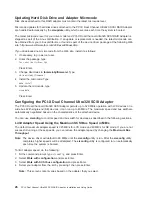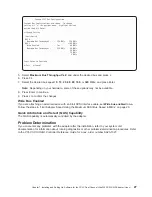
Chapter
6.
Using
Disk
Arrays
This
chapter
provides
information
about
using
the
RAID-related
features
of
this
adapter.
The
following
tasks
are
beyond
the
scope
of
this
installation
guide
and
are
usually
performed
by
system
administrators.
v
To
use
the
RAID-related
features
of
the
hardware,
disk
arrays
must
be
created
first.
v
AIX
and
Linux
use
and
manage
the
disk
array
in
the
same
way
as
it
would
a
single
non-RAID
disk.
v
For
optimum
performance,
distribute
the
hard
disk
drives
equally
across
the
available
channels.
Using
AIX
For
an
overview
of
RAID
and
detailed
procedures,
refer
to
the
PCI-X
SCSI
RAID
Controller
Reference
Guide
for
AIX,
order
number
SA23-1323.
v
Disk
drives
previously
installed
in
this
system
probably
have
512
bytes/sector.
v
To
use
the
drives
in
disk
arrays
with
this
adapter,
the
disk
drives
must
be
prepared
by
formatting
them
to
522
bytes/sector.
v
Disk
drives
in
512
bytes/sector
format
may
continue
to
be
used
as
standalone
disks
(that
is,
not
part
of
a
disk
array)
on
this
RAID
adapter.
Additionally,
drives
formatted
to
522
bytes/sector
may
be
reformatted
to
512
bytes/sector
at
a
later
time
if
desired
for
compatibility
with
previous
adapters.
v
Formatting
of
drives
to
522
bytes/sector
and
the
creation
of
disk
arrays
may
require
that
data
previously
written
on
the
drives
be
saved
and
restored
after
the
the
disk
arrays
are
created.
v
If
a
disk
array
is
to
be
used
as
the
boot
device,
it
may
be
required
to
prepare
the
disks
by
booting
from
the
Diagnostic
CD
and
creating
the
disk
array
before
installing
AIX.
You
might
want
to
perform
this
procedure
when
the
original
boot
drive
is
to
be
used
as
part
of
a
disk
array.
Using
Linux
For
an
overview
of
RAID
and
detailed
procedures,
refer
to
the
PCI-X
SCSI
RAID
Controller
Reference
Guide
for
Linux,
order
number
SA23-1327.
v
Disk
drives
previously
installed
in
this
system
are
probably
JBOD
drives.
JBOD
drives
are
formatted
to
512
bytes/sector.
v
To
use
the
drives
in
disk
arrays
with
this
adapter,
the
disk
drives
must
be
prepared
by
formatting
them
to
522
bytes/sector.
v
Disk
drives
in
512
bytes/sector
format
may
continue
to
be
used
as
standalone
disks
(that
is,
not
part
of
a
disk
array)
on
this
RAID
adapter.
Additionally,
drives
formatted
to
522
bytes/sector
for
advanced
function
may
be
reformatted
to
512
bytes/sector
at
a
later
time
if
desired
for
compatibility
with
previous
adapters.
v
Formatting
of
drives
to
522
bytes/sector
for
advanced
function
and
the
creation
of
disk
arrays
may
require
that
data
previously
written
on
the
drives
be
saved
and
restored
after
the
disk
arrays
are
created.
v
If
a
disk
array
is
to
be
used
as
the
boot
device,
it
may
be
required
to
prepare
the
disks
by
booting
into
rescue
mode
from
the
Linux
CD
first.
If
your
Linux
distribution
does
not
provide
this
feature,
the
Diagnostic
CD
may
be
used.
You
might
want
to
perform
this
procedure
when
the
original
boot
drive
is
to
be
used
as
part
of
a
disk
array.
13
Summary of Contents for Ultra320
Page 1: ...PCI X Dual Channel Ultra320 SCSI RAID Adapter Installation and Using Guide SA23 1324 01...
Page 2: ......
Page 3: ...PCI X Dual Channel Ultra320 SCSI RAID Adapter Installation and Using Guide SA23 1324 01...
Page 8: ...vi PCI X Dual Channel Ultra320 SCSI RAID Adapter Installation and Using Guide...
Page 10: ...viii PCI X Dual Channel Ultra320 SCSI RAID Adapter Installation and Using Guide...
Page 18: ...6 PCI X Dual Channel Ultra320 SCSI RAID Adapter Installation and Using Guide...
Page 24: ...12 PCI X Dual Channel Ultra320 SCSI RAID Adapter Installation and Using Guide...
Page 26: ...14 PCI X Dual Channel Ultra320 SCSI RAID Adapter Installation and Using Guide...
Page 40: ...28 PCI X Dual Channel Ultra320 SCSI RAID Adapter Installation and Using Guide...
Page 44: ...32 PCI X Dual Channel Ultra320 SCSI RAID Adapter Installation and Using Guide...
Page 46: ...34 PCI X Dual Channel Ultra320 SCSI RAID Adapter Installation and Using Guide...
Page 53: ......
Page 54: ...Part Number 80P5517 Printed in USA SA23 1324 01 1P P N 80P5517...

